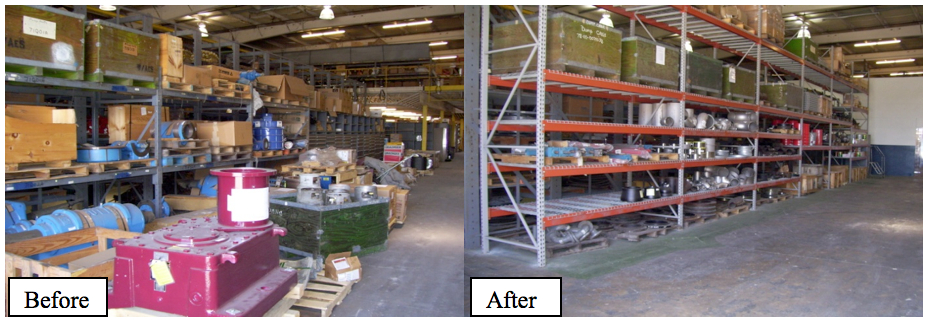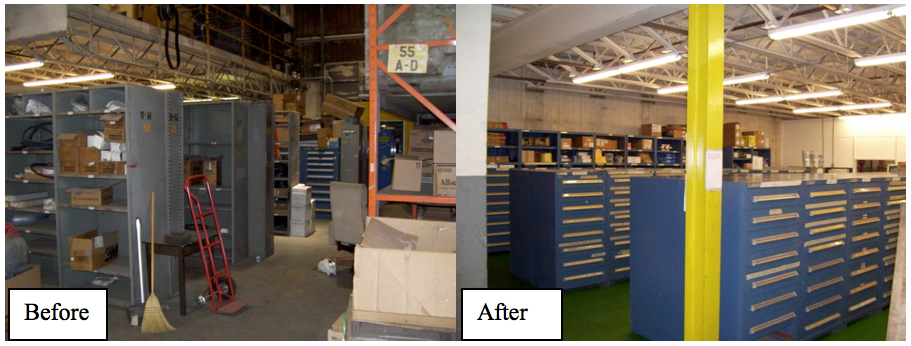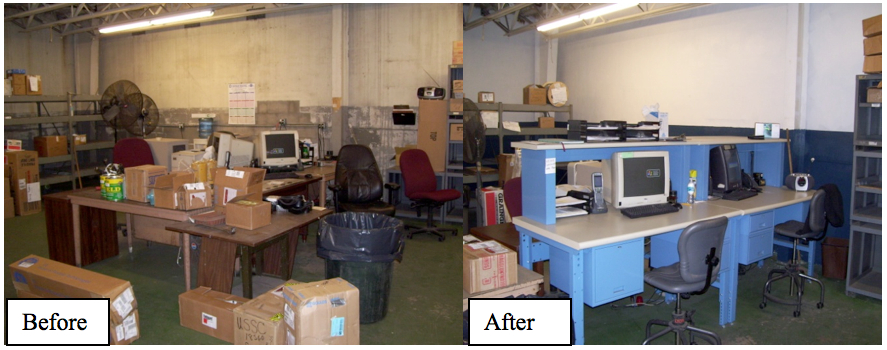Extreme Makeover: Storeroom Edition
By Wally Wilson, CMRP, CPIM, Life Cycle Engineering
If you’ve ever watched the TV show “Extreme Makeover: Home Edition”, maybe, like me, you’ve gotten a little teary-eyed as the narrator tells the story of the family’s plight. And perhaps your eyes got a little misty again at the end of the show as the bus moves forward and everyone cheers when the family sees their new home filled with features they need to improve their lives.
It would be understandable for a manager or corporate leader to get a little emotional when they realize the excess and waste in their Maintenance, Repair and Operations (MRO) storeroom and operating practices. Reviewing the waste in a single storeroom can be chilling. If there are multiple storerooms, the investment and waste can be staggering. In a recent survey of Grainger Industrial Supply’s clients respondents indicated that 73% of customers believe they have too much inventory, 87% see substantial cost-savings opportunities in their storeroom inventory “makeover” and 71% say they need to improve inventory management in their current storeroom operation.
Unlike the team on the Extreme Home Makeover show, we can’t just bulldoze the entire storeroom and start over. Many times the storeroom is the original facility that was put in place when the plant was built, including the original shelving and old pallet racks. Material handling equipment and storage systems have evolved many times through the years as have the inventory management tools – tools that provide real-time reports on inventory and part availability. Before Material Resource Planning (MRP), bar coding options, Radio Frequency Identification (RFID) capabilities and other computerized inventory management systems, parts were tracked with data punch cards and microfiche viewers. Thankfully, data punch cards and microfiche viewers have gone the way of the typewriter, but we are still facing many of the same issues we faced before we had all these sophisticated tools.
Before a storeroom makeover can begin, we need to identify a starting point. A Gap Analysis Assessment provides a snapshot of the current state of stores operation and identifies barriers and behaviors that are causing issues. As we analyze the data from the Gap Assessment it becomes apparent that the barriers and behaviors we identified as problems are actually workaround solutions the floor level employees have developed to compensate for undocumented or poorly designed work processes and undocumented changes to operating equipment. When the basic business processes for storeroom operation are abandoned, other areas of management begin to be ignored. Soon a storeroom can become dirty, and accumulate materials stacked in the aisles, safety hazards created by improper storage practices, unmanaged obsolete inventory and inventory in excess of the maximum stocking level.
Implementing a series of storeroom Kaizen projects based on the 5S visual management system is a very good starting point. Cleaning up the storeroom to identify what needs to stay and what needs to go will increase employee safety awareness and provide the shelf space needed to organize the inventory. The photos below show a Kaizen project that eliminated several safety hazards and increased storage efficiency through a small investment in new pallet racks and time for the storeroom employees to relocate the inventory in a more effective commodity grouping of items.

Adopting a practice of commodity grouping of the MRO inventory has several advantages over grouping of inventory by equipment asset. Commodity grouping of inventory items locates all bearings, motors and other like items together. The storeroom practice of grouping inventory items by equipment asset is a practice that was common before warehouse management software was available to track inventory electronically. Unfortunately this practice is still a common method of locating inventory in many MRO storerooms. The advantage of grouping spare parts inventories by equipment asset allowed the storeroom and maintenance employees to narrow their search to a specific area of the warehouse when they were searching for spare parts. The problem with asset grouping of spare parts is that it leads to duplicate inventory. If a bearing has several applications throughout the site, It’s highly likely that the bearing will be stocked in each equipment asset location..
Commodity grouping of the MRO inventory has a couple of obvious advantages. The greatest advantage of adopting commodity grouping of the MRO inventory is a reduction in inventory investment through elimination of duplicated inventory. A second benefit of commodity grouping of inventory is increased employee efficiency while stocking and picking inventory orders. Commodity grouping of inventory also allows for efficient execution of scheduled Preventive Maintenance (PM) for motors, large bearings, gearboxes and other items needing a prescribed care program while in the storeroom inventory.
When redesigning a storeroom it’s important to consider how available space is used to store inventory items. Many times the storeroom manager feels they don’t have enough space to house all the inventory the site requires. Utilizing vertical space is the most over looked option when the MRO storeroom is laid out. Understanding the volume of space available is important to utilizing all available space. When assessing space utilization in the storeroom it is important to look at spacing of pallet rack shelving and opportunities to utilize a rack system that incorporates hanging storage for hoses and items that can be stored vertically. Most of the time pallet racks are set on a standard spacing throughout the storeroom, which leads to wasted space in the majority of the pallet rack locations. High density storage cabinets utilize existing space more effectively than the old metal shelving used in many storerooms. As a general rule, installing high density storage cabinets can reduce the footprint of metal shelving by 50 to 60%. Not only do you gain higher utilization of floor space and staff, but these cabinets also provide better protection from dust, dirt and exposure to other environmental contaminants. The before and after photos below are of an area where high density storage cabinets were used to eliminate wasted space and increase the protection of stored parts from environmental exposure.

As we get the new high density storage cabinets, new pallet racks, new desks and chairs we need to address the more daunting problem of having the right parts available when they are requested. As we dig into the root cause of the problem, we discover that the storeroom isn’t always the cause of not having the right part available for the needed equipment repair. Common issues faced by MRO storerooms today include:
- Out of date Equipment Bills of Material (EBOM)
- Critical and insurance spare parts not identified
- Undocumented work processes
- High levels of obsolete inventory
- High levels of excess inventory
- Storeroom is not secured
- Undocumented inventory management practices
- High incidence of expedited purchases
- Buying from non-certified suppliers
- A reactive maintenance culture that bypasses the storeroom
These are only a few of the issues that create waste in a storeroom operation. The two main areas that can be addressed by the storeroom are the undocumented work processes and inventory management processes. For a total storeroom makeover to be successful there are about a dozen best-practice work processes that need to be developed, implemented and executed. Each of these processes needs to be developed and owned by the storeroom staff:
- Receiving process
- Incoming inspection process
- Inventory put-away process
- Inventory issue process
- Min/Max reorder point process
- Excess inventory identification process
- Obsolete inventory identification process
- Return to inventory process
- Return to supplier process
- Add-Revise-Delete process
- Planned work kitting process
- Repairable spares process
Establishing a prescribed way to perform each of the storeroom tasks removes variation in the work process and defines the responsible person that will perform each step. When developing work processes it is important to streamline the activity to remove waste and mitigate bottlenecks. As the storeroom work processes are developed and implemented it becomes clear that there are several touch points or hand-offs to other work processes within the business functions. The storeroom needs to establish documented partnerships and scheduled audits of the processes to ensure compliance. Partnerships between business units define expectations and delivered results to prevent waste in other areas of the business. An example of a department partnership is an agreement between the storeroom and maintenance department that outlines the expectations of the storeroom to supply the needed repair parts and the maintenance department’s understanding of their responsibility to the storeroom to support their efforts to meet these expectations. If each area of the business is operating as an island or a silo, it is difficult to identify issues that are creating waste in those business units and the result is a reactive business environment. Conducting audits of the storeroom work processes identifies areas that are not being followed. As these areas of non-compliance in the work processes are identified, solutions to mitigate them can be implemented and the work processes revised to reflect the changes.
Just like the data entered in a computer, if the initial receiving process isn’t performed properly, getting the invoice paid on time and being able to find the part when it is requested is probably going to be difficult. The first stop of a shipment upon entering a business is the receiving dock. Parcel shipments and palletized shipments are delivered by various carriers and require different types of equipment for unloading. Regardless of the means of delivery, the items should follow the same material flow through the receiving area. To ensure a real-time inventory system, items need to be processed through the receiving process within 24 hours. To accomplish the expected flow of material through the receiving department, the area needs to be organized and have a defined flow of material from staging area to staging area. Using an inventory bar code system is an ideal way to remove several levels of waste in the receiving process and aid in the efficient management of the MRO inventory. Barcoding the inventory also tracks any movements of the inventory to ensure the location of the part is always current. The photo below shows a receiving area that has undergone an extreme makeover. A little paint and a small investment in new equipment made this area a functional and ergonomically friendly work station for the employees. 
Once the item is entered into the warehouse inventory management system items need to be managed to ensure they are maintained in a service ready condition. A repair part that is damaged due to poor storage practices or exposure to extreme environmental conditions doesn’t have the same service life as an item that has been properly stored and maintained.
A defined cycle count process is required to ensure the right parts are available when requested. The best-practice cycle count process involves classifying inventory items by criticality and usage. Items identified as critical or insurance spares should be counted on a quarterly basis with the expectation that these items are 100% accurate all of the time. Items with high usage are the bulk of the inventory turns ratio and should be counted every six calendar months. High usage items should have an expected cycle count accuracy of 95% and compose about 80% of the total inventory value. The low dollar items are items like nuts and bolts and other low dollar inventory investments. These items should be counted annually and the expected accuracy level should be 90%. The low dollar items are prime candidates for Vendor Managed Inventory where the vendor manages the inventory levels and these items are in free issue bins in the maintenance shops or close to the point of end use.
To monitor the performance of the storeroom and define a strategy to improve performance the storeroom manager must have a set of Key Performance Indicators that show trends and deficiencies in the current performance. A matrix of Key Performance Indicators that monitor both storeroom and storeroom employee performance would include the following set of metrics.
Storeroom Metrics
- Inventory Turns Ratio – Best practice MRO inventory turns ratio is three to four turns annually
- Inventory Value – Best Practice is 0.5 to 0.75% of the Asset Replacement Value
- Inventory Issued – Dollar value of inventory issued
- Inventory Received – Dollar value of inventory received
- Inventory Transactions – Indicates the utilization of storeroom employees
- Incidence of Inventory Stock Outs – Best practice is less than 2% of total inventory requests
- Identified Obsolete Inventory – Expressed in Dollars, Best practice is less than 5%
- Excess Inventory – Items over the maximum stocking level, expressed in dollars
- Inventory Accuracy – Best practice is 95% overall inventory accuracy
- Inventory Adjustments from inventory cycle count activities
An extreme storeroom makeover is more of a journey than a one-time event. Many businesses spend thousands of dollars to make improvements to their storeroom and two to three years later they slide back into the old way of doing business. When this happens the frustration level of management and employees is even higher than before and we hear the phrase “another flavor-of-the-month failure”. The “flavor of the month” comment usually indicates that many previous initiatives have also failed to gain traction.
The easy part of this journey is implementing the changes; the hard part is executing and sustaining them. As you start any change project, keep in mind that you are not only changing the way you do business – you are also changing the expected behavior of your employees and the culture of your organization. In many cases their jobs will change and the changes could require skills upgrades to perform the revised jobs. These should not be viewed as barriers to making changes, but opportunities to develop your employees and improve the competitive position of the company. We need to “Move that Bus!” and show everyone the new storeroom.
Wally Wilson CMRP, CPIM, is a Senior Subject Matter Expert in Materials Management with Life Cycle Engineering, Charleston, South Carolina Wally has more than 25 years experience in plant management with three Fortune 500 corporations and has helped both domestic and international clients realize multi-million dollar savings through lean inventory management practices and Supply Chain optimization. You can contact him at wwilson@LCE.com.
© Life Cycle Engineering, Inc.

For More Information
843.744.7110 | info@LCE.com
